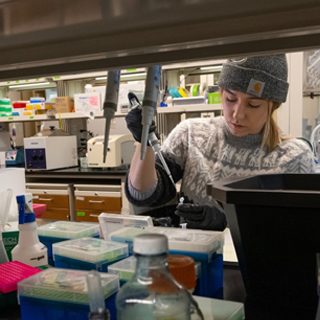Undergraduate Research
Thinking of going to graduate school? Want to find out if a career doing research is for you? Want your professional school application to stand out? Then you need research experience!
Here in the Division of Biological Sciences, we believe that research experience is a valuable part of undergraduate education and we are committed to providing undergraduates opportunities for developing their own research programs. Most DBS faculty members work with undergraduate students in their laboratories or on their field projects, and there are typically ~ 100 undergraduate students conducting research at any one time. We encourage and support many undergraduate students to present their research at conferences, and many are co-authors of publications. This high-quality mentoring is reflected by the many undergraduate students who are awarded scholarships and research awards.
So, you’ve decided you want to conduct your own research. What’s next?
Conduct Your Own Research
-

Step 1: Identify a faculty research mentor
The first step is to identify a faculty mentor/laboratory that captures your interest. Dive into the Division of Biological Sciences Faculty and/or its affiliated research centers and museums to explore your options. Another good source of potential mentors is the University of Montana's Office for Undergraduate Research. You can also check out professors in other departments on campus, like Neuroscience, Wildlife Biology, Chemistry and Biochemistry, or Biomedical and Pharmaceutical Sciences.
-

Step 2: Talk to your faculty research mentor
Once you have identified a faculty member whose research interests align with your own, the next step is to contact them to talk about joining their laboratory. It helps to know as much as you can about their research, so read some of their papers (usually listed on their website), and think about what you might want to do with them. You don’t have to know exactly, but if you have a general idea, it helps. Now, give them a call or send them an email, requesting a meeting to talk about working in their lab. Don’t be discouraged if the first couple of people are not able to work with you. Professors are very busy people, and sometimes they just don’t have the time or the space in their lab to take on a new person. Just keep trying!
-

Step 3: Receiving credit for research
If you like, you can earn UM credit for conducting your own research. Your faculty research mentor serves as the instructor of the course and can help you register for it. You can take it as a BIOB, BIOM, or BCH course, depending upon the type of research (if your faculty research mentor is in another department, the course will be in their home department; e.g. CHMY). The number of the course can be 390 or 490, depending upon the level of the work. If you are interested in presenting the results of your work as a senior thesis, you can register for BCH 499, BIOB 499, or BIOM 499 (these courses are also approved as 2/3 advanced writing courses). You can also present the results of your work at the UM Conference on Undergraduate Research or at another regional or national conference.
